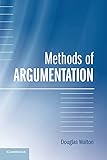Methods of argumentation / Douglas Walton, University of Windsor, Canada.
Material type: TextPublication details: New York, NY : Cambridge University Press, 2013Description: xii, 308 pages : illustrations ; 24 cmISBN: 9781107677333Subject(s): Reasoning | MATHEMATICS / LogicDDC classification: 168 WAL 2013
TextPublication details: New York, NY : Cambridge University Press, 2013Description: xii, 308 pages : illustrations ; 24 cmISBN: 9781107677333Subject(s): Reasoning | MATHEMATICS / LogicDDC classification: 168 WAL 2013 | Item type | Current library | Call number | Status | Date due | Barcode |
|---|---|---|---|---|---|
 BUKU
BUKU
|
Pusat Sumber Pendidikan IABI | Available | 0000021649 |
Includes bibliographical references (pages 287-298) and index.
Machine generated contents note: 1. Introducing some tools and basic concepts; 2. Argument attack, rebuttal, refutation, and defeat; 3. Arguments with missing parts; 4. Applying argumentation schemes; 5. Similarity, precedent, and argument from analogy; 6. Teleological argumentation to and from motives; 7. The Carneades model of scientific discovery and inquiry; 8. Fallacies, heuristics, and sophistical tactics; 9. The straw man fallacy.
"Argumentation, which can be abstractly defined as the interaction of different arguments for and against some conclusion, is an important skill to learn for everyday life, law, science, politics and business. The best way to learn it is to try it out on real instances of arguments found in everyday conversational exchanges and legal argumentation. The introductory chapter of this book gives a clear general idea of what the methods of argumentation are and how they work as tools that can be used to analyze arguments. Each subsequent chapter then applies these methods to a leading problem of argumentation. Today the field of computing has embraced argumentation as a paradigm for research in artificial intelligence and multi-agent systems. Another purpose of this book is to present and refine tools and techniques from computing as components of the methods that can be handily used by scholars in other fields"-- |c Provided by publisher.
"Argumentation, which can be abstractly defined as the interaction of different arguments for and against some conclusion, is an important skill to learn for everyday life, law, science, politics, and business. The best way to learn it is to try it out on real instances of arguments found in everyday conversational exchanges and legal argumentation. The introductory chapter of this book gives a clear general idea of what the methods of argumentation are and how they work as tools that can be used to analyze arguments. Each subsequent chapter then applies these methods to a leading problem of argumentation. Today the field of computing has embraced argumentation as a paradigm for research in artificial intelligence and multi-agent systems. Another purpose of this book is to present and refine tools and techniques from computing as components of the methods that can be handily used by scholars in other fields"-- |c Provided by publisher.

There are no comments on this title.